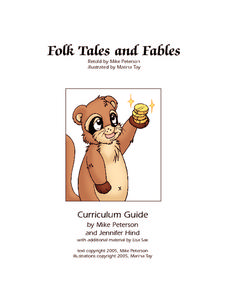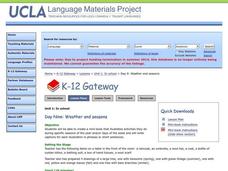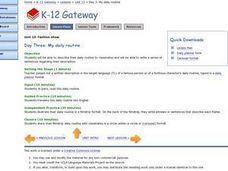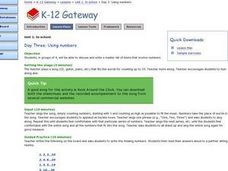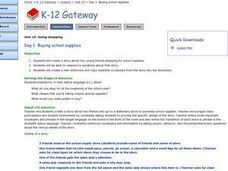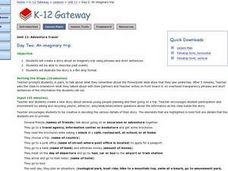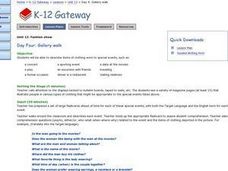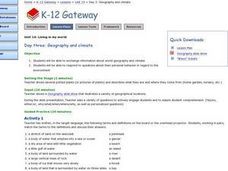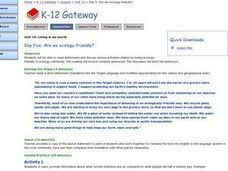Curated OER
Japanese Abstract Art And The Impressionist Movement
Students study several examples of Japanese abstract art and how this style impacted the Impressionist movement of the 19th century. This instructional activity includes ideas for student-created sketchbooks.
Weekly Story Book
Folk Tales and Fables
Pages and pages of engaging activities, worksheets, and writing projects on teaching folktales and fables await you! You don't want to miss this incredible resource that not only includes a wide range of topics and graphic...
Humanities Texas
A President's Vision: Theodore Roosevelt
Through an engaging, interactive experience analyzing primary sources, invite your young historians to take a closer look at the presidency of Theodore Roosevelt.
Curated OER
Weather and Seasons
Use pictures and manipulatives to develop vocabulary with your beginning language learners. This plan can be used with foreign language learners (although you'll have to provide the vocabulary), English language learners, or a young...
Curated OER
Family Album
Kids of all ages discover their family histories through pictures. First, flip through the PowerPoint provided (or consider making one of your own). It should show pictures of your family and have clear, easy to understand sentences that...
Curated OER
Unit 7: Family Celebrations - Day Three: Describing Pets
English language learners examine advertisements for pets and pet shelters. Students read advertisements about pets who are living in shelters. They answer comprehension questions based on the reading before writing an original...
Poetry4kids
How to Write a Cinquain Poem
A lesson challenges scholars to create a cinquain poem. Writers begin by choosing a topic and brainstorm details, then compose their original poem making sure to count syllables.
Curated OER
My Daily Routine
Foreign language learners work in pairs to translate the daily routine of celebrities or everyday people, presented in daily planner format, into English. They then illustrate and record their own daily routines in storyboard (film...
Curated OER
Gateway
Students practice listening to math problems in a foreign language. In this number sentence lesson plan, students listen to the teacher ask them a question in a foreign language that has some type of number combination for an...
Curated OER
Times of Day
Students practice telling time using a foreign language. For this time telling lesson, students listen to a teacher tell them the time in their target language as they translate it while writing. Students utilize their new...
Curated OER
My Friends: Day One: Likes and Dislikes
Students who are learning English as a second language examine likes and dislikes. In this likes and dislikes lesson, students examine the words that tell the things that a famous person might like or dislike. They work in groups to...
Curated OER
Unit 2: My Friends and I Day Three: Comparing Our Preferences
Students compare and contrast their characteristics. For this comparison lesson, ESL students compare and contrast personal characteristics while working in pairs. They use a Venn diagram and write in short phrases while making the...
Curated OER
You're Special
Students utilize a new language to tell someone they care for them. For this complimenting lesson, students practice saying nice things to friends and strangers in their target language. Students react to the lesson afterwards and...
Curated OER
Unit 10: Going Shopping Day 1: Buying School Supplies
Students, who are second language learners, develop a story about shopping. In this language development lesson, students brainstorm in their native language about the items they purchase at the beginning of the school year. They work...
Curated OER
An Imaginary Trip
Students use their imaginations to write about an imaginary trip. In this creative writing lesson, students write about an imaginary trip. Students brainstorm writing ideas as a class and use past tense words in their...
Curated OER
Unit 13: Fashion Show - Day Four: Gallery Walk
Students practice the vocabulary associated with clothing that is worn to special events. In this clothing vocabulary lesson, students, who are ESL learners, practice using works that describe clothing items that are worn for a concert,...
Curated OER
Geography and Climate
Young scholars investigate geographical locations and their own personal experiences with the environment. In this environmental identification lesson, students participate in a match game using certain environmental and...
Curated OER
Are We Ecology-Friendly?
Students explore ecology. For this ecology lesson, students read scenarios, discuss them in groups and decide if they are eco-friendly or not. Students discuss the differences in eco-friendly practices fifty years ago and now. Students...
Curated OER
Looking at French Decorative Arts: Makers of Nothing, Sellers of Everything
Students imagine they are a 'marchand-mercier' (or salesman) and write a persuasive letter to sell French items. In this art analysis lesson plan, students identify the role of a 'marchand-mercier' and write a three-paragraph letter to...
Curated OER
Greetings
Young scholars participate in greeting new people. In this greetings lesson, students greet people after modeling by the teacher. Sample rituals include, "Hello, how are you?; My name is...What is your name?". Young scholars...
Curated OER
Day Two: Greeting and dialogues
Young scholars practice greetings and dialogues in English. For this ELL lesson, students watch a silent video with people greeting one another and make predictions about what they are saying. They write dialogues and share them with a...
Curated OER
Parts of the Body
Fifth graders create a quiz. In this parts of the body lesson, 5th graders identify and illustrate body parts. With a partner, students create a quiz on the terms used during the lesson.
Curated OER
The alphabet
Students write words that the teacher spells out orally. In this alphabet lesson plan, the teacher signs the words to music and the students write them down.
Curated OER
Months of the Year
Students practice interviewing. In this months of the year lesson, students interview at least five adults working in their school to gather data on when their birthdays occur. Students create a master calendar for the school.

